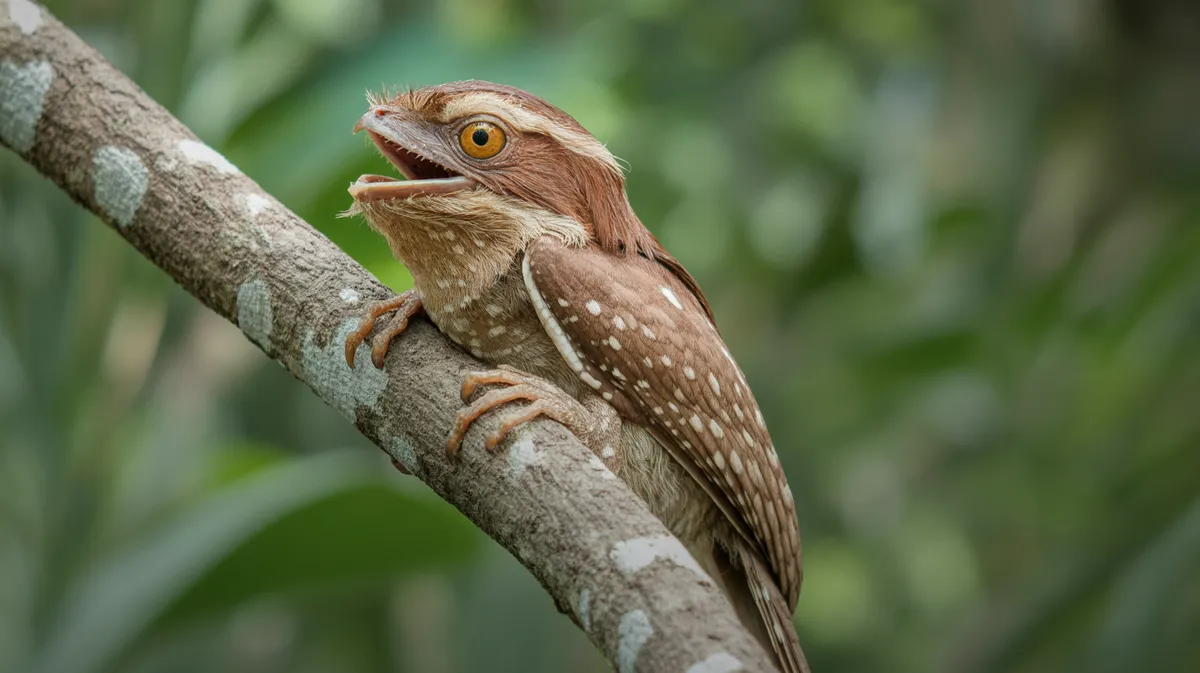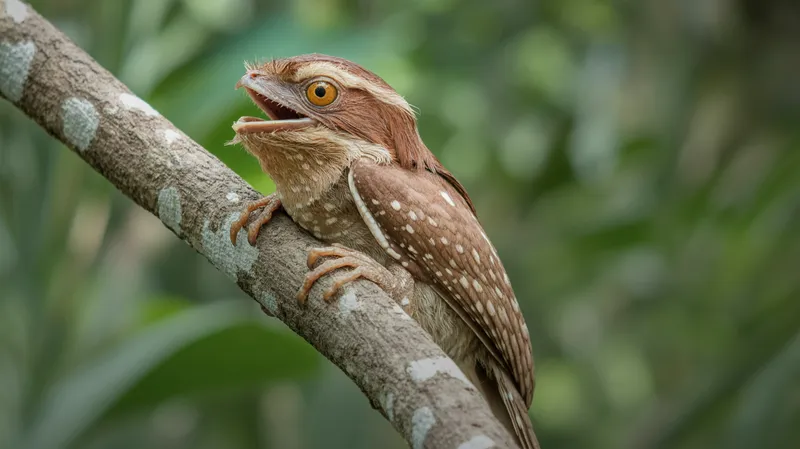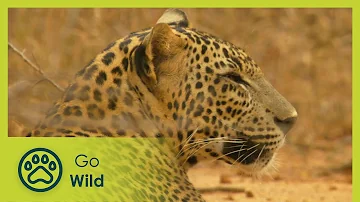
Sri Lankan Frogmouth
Batrachostomus moniliger

Meet the Sri Lankan Frogmouth
The Sri Lankan Frogmouth is a nocturnal bird native to the forests of Sri Lanka and the Western Ghats of southern India. It is known for its wide, frog-like gape and cryptic plumage, which provides excellent camouflage among branches and leaf litter. These birds are generally elusive and often remain motionless during the day, blending seamlessly into their arboreal surroundings. The Sri Lankan Frogmouth is primarily active at night, feeding on insects and other small invertebrates. Its haunting, low-pitched call is a distinctive feature of the dense, humid forests it inhabits.
Classification
Bird
Habitat
Tropical and subtropical moist forests
Diet
Insectivore
Lifespan
Up to 10 years
Conservation
Least Concern
Weight
40–60 grams
📖Fascinating Facts
Master of Disguise
The Sri Lankan Frogmouth’s mottled brown and grey plumage makes it almost invisible when perched on a branch, mimicking dead leaves.
Insect Eater
Its diet consists mainly of moths, beetles, and other insects, which it catches during its nocturnal foraging.
Unique Nesting Habits
The species builds a small, pad-like nest on a horizontal branch, often decorating it with lichen and moss to enhance camouflage.
📋Detailed Description
The Sri Lankan Frogmouth (Batrachostomus moniliger) is a small, nocturnal bird measuring approximately 23 cm (9 inches) in length, with a wingspan of about 30–35 cm. Its most distinctive anatomical feature is its broad, flattened bill, which is fringed with bristles and adapted for catching insects in flight. The plumage is highly cryptic, resembling dead leaves or bark, with mottled shades of brown, grey, and rufous; this camouflage is so effective that the bird can be virtually invisible when roosting. Sexual dimorphism is present: males are generally greyer, while females display a more rufous coloration. The eyes are large and dark, enhancing night vision. During the day, individuals roost singly or in pairs on low branches, often returning to the same spot unless disturbed. At dusk and dawn, they become active, emitting a series of low, guttural calls that can carry through dense forest. The Sri Lankan Frogmouth is primarily insectivorous, feeding on moths, beetles, and other nocturnal arthropods, which it captures using its wide gape. Its legs are short and weak, reflecting its arboreal lifestyle and infrequent movement on the ground. The species is generally solitary or found in monogamous pairs, with strong site fidelity to roosting and nesting locations.
💡 Did you know?
Despite their name and appearance, Sri Lankan Frogmouths are not related to frogs but get their name from their wide, gaping mouths.
🔬Research & Sources
Wikipedia Summary
The Sri Lanka frogmouth, Sri Lankan frogmouth or Ceylon frogmouth is a small frogmouth found in the Western Ghats of south India and Sri Lanka. Related to the nightjars, it is nocturnal and is found in forest habitats. The plumage coloration resembles that of dried leaves and the bird roosts quietly on branches, making it difficult to see. Each has a favourite roost that it uses regularly unless disturbed. It has a distinctive call that is usually heard at dawn and dusk. The sexes differ slightly in plumage.
Last Modified: 11/6/2024
🎭Behavior & Social Structure
Sri Lankan Frogmouths are strictly nocturnal, spending daylight hours motionless on branches, often adopting a posture with the head held upwards and the bill pointed to mimic a broken branch. This behavior, combined with their cryptic plumage, makes them extremely difficult to detect. They are ambush predators, sallying out from perches to snatch flying insects, or gleaning prey from foliage. Social interactions are limited outside of the breeding season, with pairs maintaining loose territories. Vocalizations are most frequent at dawn and dusk, consisting of a series of resonant, frog-like calls used for mate communication and territory advertisement. They are generally silent during the day. Roosting sites are reused regularly, and individuals show strong attachment to favored perches.
👶Reproduction & Life Cycle
Breeding occurs mainly during the southwest monsoon (May–September in India, March–July in Sri Lanka), coinciding with increased insect abundance. The nest is a small, shallow cup constructed from moss, lichens, and bark fragments, bound together with spider silk and attached to a horizontal branch, often overhanging a stream or forest path. Only one egg is laid per clutch. Both parents participate in incubation, which lasts about 29–31 days. After hatching, the chick is brooded and fed by both adults, fledging at around 20–22 days old. Parental care is extensive, with adults remaining highly vigilant and using distraction displays to deter predators. Breeding pairs are monogamous and may remain together for multiple seasons.
🛡️Adaptations & Survival
The Sri Lankan Frogmouth exhibits several unique adaptations: its cryptic plumage and motionless daytime posture provide exceptional camouflage against predators. The wide, bristled gape is specialized for catching flying insects at night. Large eyes with a high density of rod cells enhance low-light vision. The use of spider silk in nest construction increases nest strength and flexibility. Behavioral adaptations include site fidelity to safe roosts and nests, and the use of distraction displays to protect offspring. Their vocalizations are adapted for low-frequency transmission through dense forest, allowing communication over distance without revealing their precise location to predators.
📚Research Sources
🎨Cultural Significance
The Sri Lankan Frogmouth is not widely featured in local folklore or mythology, likely due to its secretive habits and nocturnal lifestyle. However, its unusual appearance and haunting calls have occasionally inspired local superstitions associating it with omens or spirits in rural communities. Birdwatchers and ecotourists prize sightings of this elusive species, contributing to its recognition as a flagship species for forest conservation in the Western Ghats and Sri Lanka.
🔬Recent Research & Discoveries
Recent research has focused on the species' vocalizations, revealing individual and regional variation in calls, which may play a role in mate recognition and territory establishment. Studies using molecular phylogenetics have clarified its relationship to other frogmouths and nightjars, supporting its placement in the Podargidae family. Ongoing ecological studies are examining its adaptability to fragmented habitats and the effects of forest management practices. There is interest in the species as an indicator of forest health due to its sensitivity to habitat disturbance.
🎥Wildlife Videos

Sri Lankan Frogmouth | මැඩිමුහුණා | Batrachostomus moniliger 🦉 Wildlife Documentary Full HD #nature
Sri Lankan Frogmouth | මැඩිමුහුණා | Batrachostomus moniliger Family: Podargidae In the heart of the Western Ghats of ...
Wawekale

මැඩි මුහුණා - Sri Lankan Frogmouth
Join me on a journey deep into Sri Lanka's rainforests to witness the elusive Sri Lankan Frogmouth (Batrachostomus moniliger) in ...
To Nature with Ajith

Discovering the Elusive Sri Lanka Frogmouth | Nature’s Nocturnal Marvel
Join us on an enchanting journey into the dense forests of Sri Lanka and the Western Ghats of India to uncover the secrets of the ...
Wild life Explore

Sri Lanka: Monsoon Island - Wildest Islands - Go Wild
Lying like a teardrop in the Indian Ocean, Sri Lanka is an island that defies convention. Poised just six degrees above the equator, ...
Go Wild

The Sri Lanka Frogmouth
What a cool looking bird!! #wildlife #animals #facts #nature #biology #animalfacts #asia #india #indianwildlife #srilanka ...
WinterWolf

Ceylon Frogmouth | Animal Planet | Wild Sri Lanka | Ceylon Wild Tales | Rare Birds
A couple of rarely seen frog mouth birds were found resting in a shaded bush near the Kudawa entrance at Sinharaja rain forest, ...
Ceylon Wild Tales
🌍Habitat Information
The Sri Lankan Frogmouth typically inhabits Tropical and subtropical moist forests environments. Sri Lankan Frogmouths have adapted to their environments with specialized features and behaviors.
Primary Habitat:
Tropical and subtropical moist forests
More detailed habitat information will be available soon.
🛡️Conservation Status
The Sri Lankan Frogmouth is currently classified as Least Concern. Conservation efforts are crucial for preserving this species for future generations.
Common Threats:
- 🏠Habitat loss and fragmentation
- 🌡️Climate change impacts
- 🎯Hunting and poaching
- 🏭Human-wildlife conflict
⚠️Threats & Conservation Challenges
Currently assessed as Least Concern by the IUCN, the Sri Lankan Frogmouth faces localized threats from habitat loss, particularly deforestation and fragmentation of tropical forests in both Sri Lanka and the Western Ghats. Agricultural expansion, logging, and human encroachment reduce available habitat and may isolate populations. Although the species tolerates secondary growth and some disturbed habitats, long-term survival depends on the preservation of large tracts of forest. There is no evidence of significant population decline at present, but continued habitat degradation could pose future risks.
🔬Scientific Classification
Scientific Name
Batrachostomus moniliger
Classification Hierarchy
🔍 About Taxonomic Classification
Taxonomic classification is a hierarchical system used by scientists to classify and organize living organisms based on shared characteristics and evolutionary relationships.
The system moves from broad categories (Kingdom) to increasingly specific ones, with each animal's scientific name typically consisting of its Genus and species.
📝Community Notes
Share your observations and insights about the Sri Lankan Frogmouth with our community of wildlife enthusiasts.
Join Our Community
Sign in to share your observations and connect with fellow wildlife enthusiasts.
Sign In to ContributeNo community notes yet
Be the first to share your observations about the Sri Lankan Frogmouth!
Explore Sri Lankan Frogmouth
Select a tab above to learn more about this amazing animal.
📸Photo Gallery
No photos available for this animal yet.
🌟Discover More Wildlife
Continue your journey of discovery with more fascinating animals from our database
